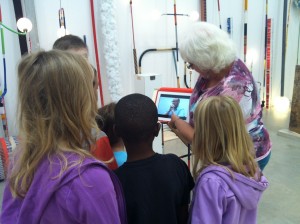
With a $4,500 grant from the Marcus Institute for Digital Education in the Arts, the Blaffer Art Museum has added iPads to enhance their tours. The iPads provide interviews with the artist and curators. | Courtesy of Katherine Veneman
Blaffer Art Museum can be an intellectual challenge for some patrons as they struggle to grasp or initiate the dialogue between themselves and the artwork.
Blaffer is trying to eliminate this wall to progress the dialogue between spectators and the bold, contemporary art that the museum is known for through cutting-edge technology.
With the acquired $4,500 grant from the Marcus Institute for Digital Education in the Arts, Blaffer has revamped its tours by adding iPads. Additional pictures, notes and 1-minute video interviews of the artists, curators and the museum’s director will give visitors a chance to create a sphere of better understanding and appreciation.
“iPads will offer visitors an opportunity to hear from the artists themselves, which bring the works to life,” said Curator of Education Katherine Veneman. “They also provide an extra layer of interactivity with the exhibitions. They’re interpretative tools that enhance the museum tour experience.”
Andy Coolquitt’s “Attainable Excellence” presents his construction of abstract expressionist sculptural installations and is exhibiting on the museum’s first floor. His work presentation will be the first collection to receive the supplementary iPad treatment by including short interviews of him and his curator, Rachel Hooper.
“I think that it is exciting to see how much imaginations are activated by offering so many platforms for learning — a video, a picture, an audio clip — that can respond to what is interesting and important to the viewer’s experience,” Veneman said.
Guided tours like the Saleri Studio Saturday are just one of the ways the Blaffer has intertwined art and technology.
“Visitors have thus far embraced the technology naturally, as an integral part of their tour,” Veneman said.
“In the future, the learning environment of museums is becoming more and more interactive, and visitors will continue to participate — our upcoming exhibition, Feast, will showcase this.”
The induction of new iPads has enabled the museum to extend its reach to those who might have otherwise stumbled out of the doors as quickly as they stumbled in.
“You kind of have to give them a foundation and structure,” said Kristin Lehmer, a docent and communication sciences disorders graduate student.
“I know I get more out of it when I meet the artist. It allows you to open your world bigger to see things.”
arts@thedailycougar.com
